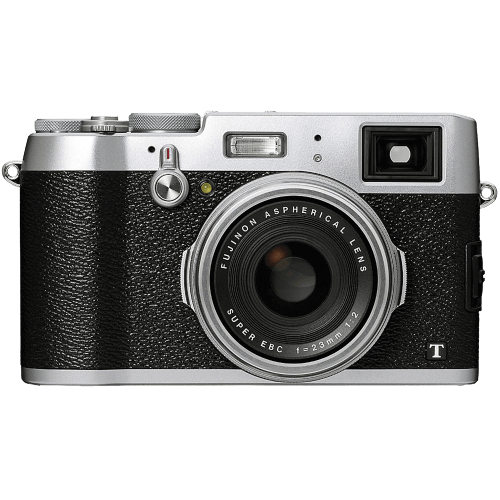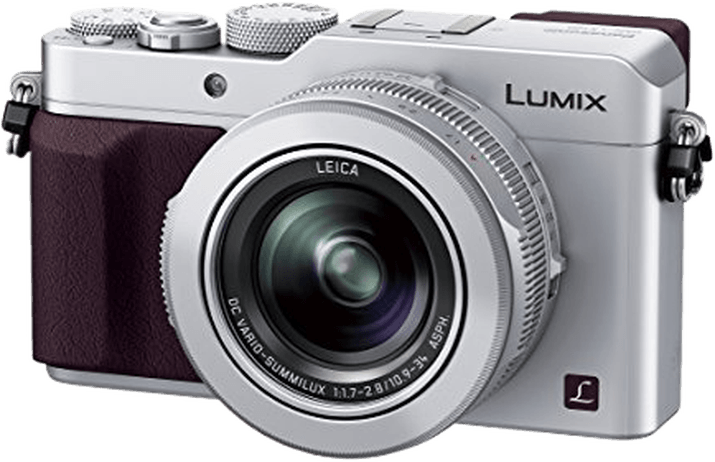Fujifilm X100T vs Panasonic Lumix DMC-LX100 Comparison
Fujifilm X100T

Panasonic Lumix DMC-LX100

The Fujifilm X100T outperforms the Panasonic Lumix DMC-LX100, scoring 53/100 compared to the latter’s 49/100. Both cameras share similarities, such as being released in the mid-2010s, with the X100T in 2015 and the LX100 in 2014. Additionally, both have similar dimensions and weight, with the X100T measuring 127 x 74 x 52mm and weighing 440g, while the LX100 is 115 x 66 x 55mm and weighs 393g.
The X100T is a superior camera due to its higher score. It has a higher launch price of $1300, indicating better features and quality compared to the LX100’s $899 price tag. However, the LX100 has its advantages, such as being slightly more compact and lighter.
Taking these points into account, the Fujifilm X100T is the better camera overall, but the Panasonic Lumix DMC-LX100 may be a more suitable choice for those prioritizing size and weight.
Fujifilm X100T vs Panasonic Lumix DMC-LX100 Overview and Optics
The Panasonic Lumix DMC-LX100 wins in optics with a score of 56/100, while the Fujifilm X100T scores 54/100. Both cameras share some specifications, such as having a CMOS sensor, a fixed lens mount, and no option to change lenses.
The Lumix DMC-LX100 has several advantages over the X100T. It features a higher shooting speed of 11 compared to 6, which allows for faster continuous shooting. Furthermore, the LX100 has a DXOMARK score of 67 for its sensor, while the X100T does not have a score due to DXOMARK not scoring Fujifilm cameras. Additionally, the LX100 has image stabilisation, which helps reduce blur from camera shake, and a 4:3 aspect ratio, providing a more square image format.
On the other hand, the Fujifilm X100T has a higher megapixel count of 16 compared to the LX100’s 12.8, which can result in more detailed images. The X100T also features an APS-C sensor size, larger than the LX100’s Micro Four Thirds sensor, which can potentially provide better image quality and low-light performance. Lastly, the X100T has a 3:2 aspect ratio, offering a more rectangular image format.
In terms of optics, the Panasonic Lumix DMC-LX100 outperforms the Fujifilm X100T with its faster shooting speed, image stabilisation, and a higher DXOMARK sensor score. However, the X100T offers a higher megapixel count and a larger sensor size, which may be preferable for some users. Ultimately, the choice between these cameras will depend on individual preferences and specific photography needs.
Fujifilm X100T vs Panasonic Lumix DMC-LX100 Video Performance
The Fujifilm X100T and Panasonic Lumix DMC-LX100 both have a video score of 70/100, indicating that they share similar video capabilities. Both cameras offer built-in time-lapse functionality, allowing users to create stunning time-lapse videos.
Despite having the same video score, the Panasonic Lumix DMC-LX100 stands out with its 4K video resolution and maximum video dimensions of 3840 x 2160. In contrast, the Fujifilm X100T only supports Full HD video resolution with maximum video dimensions of 1920 x 1080. This difference means that the Lumix DMC-LX100 can capture higher quality videos with more detail and clarity than the X100T.
However, the Fujifilm X100T has an advantage in terms of maximum video frame rate, offering 60fps compared to the Lumix DMC-LX100’s 30fps. This higher frame rate allows for smoother video playback and better slow-motion video capabilities in the X100T.
In terms of video capabilities, the Panasonic Lumix DMC-LX100 is superior due to its 4K video resolution, which results in higher quality videos with greater detail. However, the Fujifilm X100T has a higher maximum video frame rate, providing smoother video playback and better slow-motion capabilities. Users who prioritize video resolution and detail should opt for the Lumix DMC-LX100, while those who value smooth playback and slow-motion features may prefer the X100T. Ultimately, both cameras have their strengths and weaknesses, and the choice depends on individual preferences and requirements.
Fujifilm X100T vs Panasonic Lumix DMC-LX100 Features and Benefits
The Fujifilm X100T emerges as the winner in the comparison of features, with a score of 58/100, while the Panasonic Lumix DMC-LX100 has a lower score of 41/100. Both cameras share some common specifications, such as a 3-inch screen size, no touchscreen, a flip screen, no GPS, and WIFI connectivity.
The Fujifilm X100T has a higher screen resolution of 2,360,000 dots, compared to the Panasonic Lumix DMC-LX100’s 921,000 dots. This higher resolution results in a clearer and sharper display on the Fujifilm X100T. Additionally, the Fujifilm X100T offers Bluetooth connectivity, which the Panasonic Lumix DMC-LX100 lacks. Bluetooth allows for easier and faster transfer of files between devices, making the Fujifilm X100T more convenient for sharing and backing up images.
On the other hand, the Panasonic Lumix DMC-LX100 does not have any significant advantages over the Fujifilm X100T in terms of features. Both cameras are equal in most aspects, with the Fujifilm X100T having a slight edge due to its higher screen resolution and Bluetooth connectivity.
Taking the above points into consideration, the Fujifilm X100T is the superior camera in terms of features. Its higher screen resolution provides a better user experience when reviewing and editing images, while Bluetooth connectivity adds convenience for file transfers. The Panasonic Lumix DMC-LX100 does not offer any notable advantages in this comparison, making the Fujifilm X100T the clear winner.
Fujifilm X100T vs Panasonic Lumix DMC-LX100 Storage and Battery
The Fujifilm X100T outperforms the Panasonic Lumix DMC-LX100 in storage and battery, scoring 21/100 compared to the LX100’s 16/100. Both cameras have one memory card slot and accept SD, SDHC, and SDXC (UHS-I compatible) cards. They also lack USB charging capabilities.
The X100T’s edge comes from its superior battery life, offering 330 shots per charge compared to the LX100’s 300 shots. The X100T uses a Lithium-Ion NP-95 battery, while the LX100 uses a DMW-BLG10E battery. This 10% increase in battery life makes the X100T more reliable for extended shooting sessions.
The LX100 does not surpass the X100T in any aspect of storage and battery. Its lower score highlights its slightly weaker performance in this area.
Considering these factors, the Fujifilm X100T proves to be the better choice for photographers prioritizing storage and battery capabilities. The Panasonic Lumix DMC-LX100, while not as strong in this aspect, remains a viable option for those with less demanding battery requirements.
Fujifilm X100T vs Panasonic Lumix DMC-LX100 – Our Verdict
Are you still undecided about which camera is right for you? Have a look at these popular comparisons that feature the Fujifilm X100T or the Panasonic Lumix DMC-LX100:

